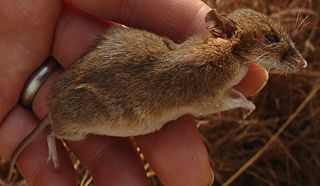
The term spiny mouse refers to any species of rodent within the genus Acomys. Similar in appearance to mice of the genus Mus, spiny mice are small mammals with bare, scaled tails. However, their coats are endowed with unusually stiff guard hairs similar to the spines of a hedgehog; this trait is the source of the common name, spiny mouse.
The link rat is a species of rodent in the family Muridae. It is also known by the common name Congo forest mouse. It is native to central Africa.

Rudd's mouse or the white-bellied brush-furred rat is the only member of the genus Uranomys. This animal is closely related to the spiny mice, brush-furred mice, and the link rat.

The golden spiny mouse gets its name from the reddish-orange spiny fur that covers its body from head to tail. This coarse, inflexible fur is thought to protect it from predation. Aside from the golden fur that covers its head and upper parts, its flanks are yellow and its underside is pale. It has gray legs with pale feet and black soles. It is also described as having a small, but distinct white spot under each eye. It is often found in the wild missing a part or all of its tail because it is able to shed this as a defense mechanism. However, it is not known how this is done, how often it can occur, or under what conditions. It lives an average of three years in the wild. It is omnivorous and feeds on seeds, desert plants, snails, and insects. Living in desert regions, it is a xeric animal that obtains water from the plants that it eats and produces very concentrated urine in order to conserve water. A. russatus is naturally nocturnal, but adapts to being diurnal when it shares a habitat with A. cahirinus.
The Western Saharan spiny mouse or Aïr spiny mouse is a species of small, insectivorous rodent in the family Muridae found arid regions of western Africa.

The Cairo spiny mouse, also known as the common spiny mouse, Egyptian spiny mouse, or Arabian spiny mouse, is a nocturnal species of rodent in the family Muridae. It is found in Africa north of the Sahara, where its natural habitats are rocky areas and hot deserts. It is omnivorous and feeds on seeds, desert plants, snails, and insects. It is a gregarious animal and lives in small family groups. It is the first and only known rodent species that exhibit spontaneous decidualization and menstruation.
Chudeau's spiny mouse is a species of rodent in the family Muridae found in Mauritania and Morocco. Its natural habitats are rocky areas and hot deserts.

The Asia Minor spiny mouse is a species of rodent in the family Muridae.
The fiery spiny mouse is a species of rodent in the family Muridae found in Kenya and Tanzania. Its natural habitats are dry savanna and rocky areas. It may be found as a commensal in human habitations.
Johan's spiny mouse is a species of rodent in the family Muridae. It is found in Benin, Burkina Faso, Cameroon, Chad, Ghana, Mali, Niger, Nigeria, and Togo. Its natural habitats are subtropical or tropical dry shrubland, subtropical or tropical dry lowland grassland, and rocky areas.
Kemp's spiny mouse is a species of rodent in the family Muridae. It is found in Kenya, Somalia, and Tanzania. Its natural habitats are dry savanna and rocky areas. It is one of only two mammals, the other being Acomys percivali, which can shed its skin. In addition, it is known to be capable of completely regenerating damaged tissue, including hair follicles, skin, sweat glands, fur and cartilage.
The Mullah spiny mouse is a species of rodent in the family Muridae found in Djibouti, Eritrea, Ethiopia, and Somalia. Its natural habitats are subtropical or tropical dry shrubland and rocky areas.

Seurat's spiny mouse is a species of rodent in the family Muridae. It is found only in Algeria. Its natural habitats are rocky areas and hot deserts.
The southern African spiny mouse is a species of rodent in the family Muridae. It is found in Botswana, Democratic Republic of the Congo, Malawi, Mozambique, South Africa, Tanzania, Zambia, and Zimbabwe. Its natural habitats are moist savanna and rocky areas.

The Cape spiny mouse is a murid rodent found in the Western Cape Province of South Africa. They have a dorsal covering of spiny hairs with dark grey-brown coloration, and a white underbelly. The Cape Spiny Mouse has large eyes and ears and a scaly, nearly bald tail that is brittle and can break off readily either as a whole or in part if it is caught. Their total length is 17 cm (6.7 in), with an 8 cm (3.1 in) tail, and they typically weigh 22 g (0.78 oz).
Wilson's spiny mouse is a species of rodent in the family Muridae. It is found in Ethiopia, Kenya, Somalia, South Sudan, Tanzania, and Uganda. Its natural habitats are dry savanna, subtropical or tropical dry shrubland, and rocky areas.

The eastern spiny mouse or Arabian spiny mouse is a species of rodent in the family Muridae. They have a wide range, having been found in Middle Eastern deserts, as well as being prevalent in riverine forests in Africa. This is the only species of spiny mouse which may have black coloration. Their diet is similar to other species of spiny mouse, consisting mostly of seeds.







